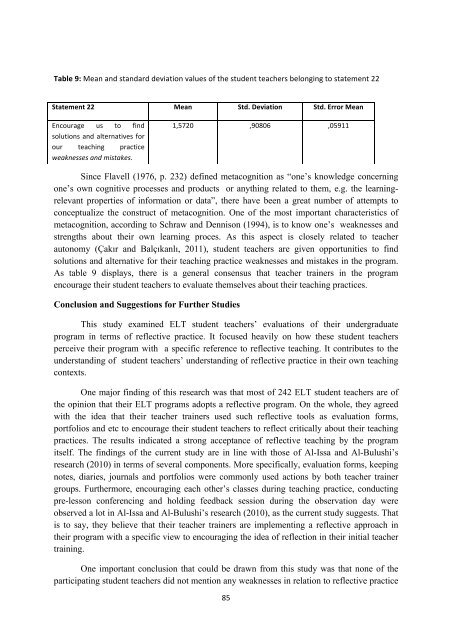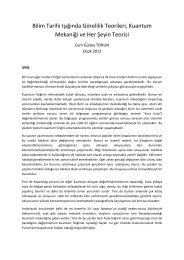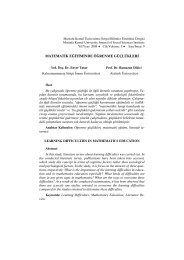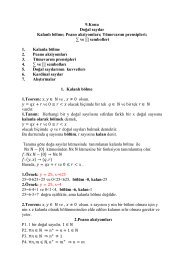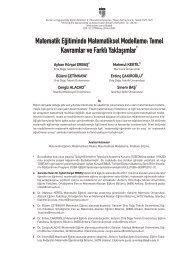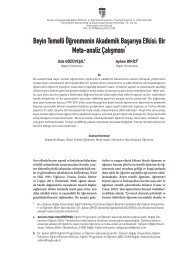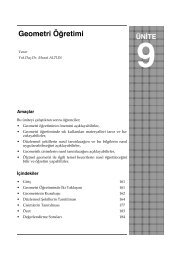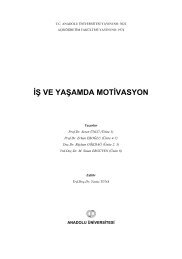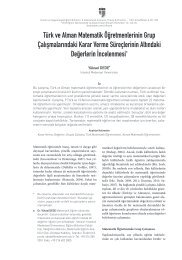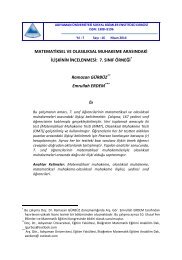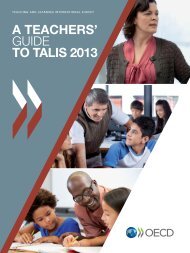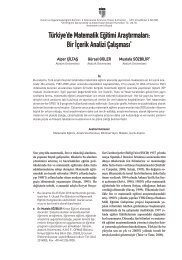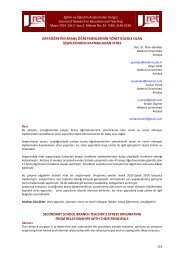Ufuk-U_niversitesi-SBE-Dergisi-S-ayı-5-kopya
Ufuk-U_niversitesi-SBE-Dergisi-S-ayı-5-kopya
Ufuk-U_niversitesi-SBE-Dergisi-S-ayı-5-kopya
You also want an ePaper? Increase the reach of your titles
YUMPU automatically turns print PDFs into web optimized ePapers that Google loves.
Table 9: Mean and standard deviation values of the student teachers belonging to statement 22 Statement 22 Mean Std. Deviation Std. Error Mean Encourage us to find solutions and alternatives for our teaching practice weaknesses and mistakes. 1,5720 ,90806 ,05911 Since Flavell (1976, p. 232) defined metacognition as “one’s knowledge concerningone’s own cognitive processes and products or anything related to them, e.g. the learningrelevantproperties of information or data”, there have been a great number of attempts toconceptualize the construct of metacognition. One of the most important characteristics ofmetacognition, according to Schraw and Dennison (1994), is to know one’s weaknesses andstrengths about their own learning proces. As this aspect is closely related to teacherautonomy (Çakır and Balçıkanlı, 2011), student teachers are given opportunities to findsolutions and alternative for their teaching practice weaknesses and mistakes in the program.As table 9 displays, there is a general consensus that teacher trainers in the programencourage their student teachers to evaluate themselves about their teaching practices.Conclusion and Suggestions for Further StudiesThis study examined ELT student teachers’ evaluations of their undergraduateprogram in terms of reflective practice. It focused heavily on how these student teachersperceive their program with a specific reference to reflective teaching. It contributes to theunderstanding of student teachers’ understanding of reflective practice in their own teachingcontexts.One major finding of this research was that most of 242 ELT student teachers are ofthe opinion that their ELT programs adopts a reflective program. On the whole, they agreedwith the idea that their teacher trainers used such reflective tools as evaluation forms,portfolios and etc to encourage their student teachers to reflect critically about their teachingpractices. The results indicated a strong acceptance of reflective teaching by the programitself. The findings of the current study are in line with those of Al-Issa and Al-Bulushi’sresearch (2010) in terms of several components. More specifically, evaluation forms, keepingnotes, diaries, journals and portfolios were commonly used actions by both teacher trainergroups. Furthermore, encouraging each other’s classes during teaching practice, conductingpre-lesson conferencing and holding feedback session during the observation day wereobserved a lot in Al-Issa and Al-Bulushi’s research (2010), as the current study suggests. Thatis to say, they believe that their teacher trainers are implementing a reflective approach intheir program with a specific view to encouraging the idea of reflection in their initial teachertraining.One important conclusion that could be drawn from this study was that none of theparticipating student teachers did not mention any weaknesses in relation to reflective practice85


